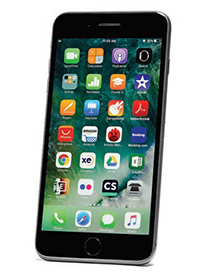 Apple essentially caters to a class of people who have higher disposable income and this strategy has earned them a dedicated fan following. The iPhone 7 Plus is aimed at those who form the cream even among this crowd. And Apple has done it in style this time with innovations in style and processing that will go a long way into strengthening this cult following. We published a preview of the device in our November issue, and here is our in-depth review.
Apple essentially caters to a class of people who have higher disposable income and this strategy has earned them a dedicated fan following. The iPhone 7 Plus is aimed at those who form the cream even among this crowd. And Apple has done it in style this time with innovations in style and processing that will go a long way into strengthening this cult following. We published a preview of the device in our November issue, and here is our in-depth review.
Design and Build Quality
The iPhone 7 Plus is available in two new colours in addition to the ones that iPhones sported till now—Matte Black and Jet Black. We received the Matte Black version, and it has a classy look. The 7 Plus has an aluminium unibody design that is splash and water resistant with an IP 67 rating, a first in an iPhone. The device feels quite sturdy, and the 2.5D curved glass enhances its visual appeal. The iPhone 7 Plus uses a dual camera system and the lenses are mounted adjacent to the flash and sensor window. The Apple logo at the back has a glossy finish. As you may be already aware, Apple has done away with the headphone jack, and now the lightning port doubles as a headphone jack. The lightning port is at the bottom along with the speaker holes.
Key Features
At the heart of the iPhone 7 Plus is the A10 Fusion Chip that lets the device perform twice as fast as the iPhone 6. This quad-core processing unit consists of two high-performance cores along with two high-efficiency cores. The high-performance cores act as power boosters to enable processor-intensive applications while the high-efficiency cores ensure low power consumption while performing normal tasks. This optimally manages the battery efficiency of the system without compromising on processing power. The 7 Plus has 3GB RAM and is available in three variants of 32GB, 128GB and 256GB internal memory. The device accepts a single nano SIM. The device uses iOS 10 platform.
The iPhone 7 Plus uses a 5.5-inch Retina HD display, which, according to Apple, is the brightest and most colourful iPhone display yet with wider gamut and 25 percent more brightness. The display has a native resolution of 401ppi.
As mentioned before, the iPhone 7 Plus uses a dual camera system. But unlike some other smartphones that use both two lenses simultaneously, the 7 Plus uses two imagers in place of optical zoom. The lenses have fixed foci of 28mm and 56mm, and apertures of f/1.8 and f/2.8 respectively. The underlying sensors are identical 12-megapixel devices. Though the imaging devices are separate, the output mechanism is common. In normal mode (1x zoom), the 7 Plus uses the 28mm imager and shifts to the 56mm unit the moment you select 2x optical zoom. This eliminates the sophistication of incorporating moving elements in the lens, and at the same time, retains the original quality. Both the lenses are equipped with optical image stabilisation and feature a 6-element design. The camera unit features a true tone flash. The front camera is a 7-megapixel model. The camera now features a new Portrait mode, which was, till recently, in Beta. The Portrait mode provides a depth-offield (bokeh) effect, and instructs you to move further if you are too close. Other modes are Time-Lapse, Slow- Motion, Video, Square, and Panorama. The native camera app does not offer manual controls. However, there are competitive and full featured third party apps for this. Sadly, they are paid downloads.
Though Apple has done away with the 3.5mm audio jack, the device is shipped with an EarPod having a Lightning connector. Apple has also included a 3.5mm headphone jack adapter to plug into the Lightning port. As mentioned in our preview, this prevents you from listening to music while the device is charging, negating any chance of overheating (though it is not the primary reason for the design change).
The iPhone 7 Plus is powered by a 3000mAh battery. The device measures 158.2 x 77.9 x 7.3mm and weighs 188g.

